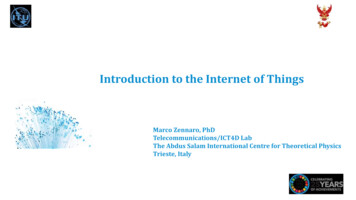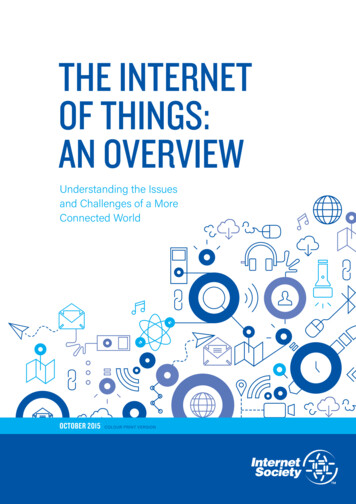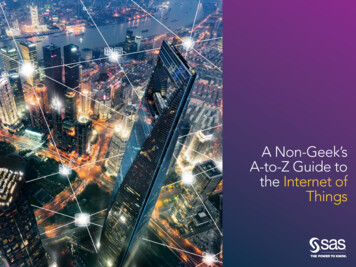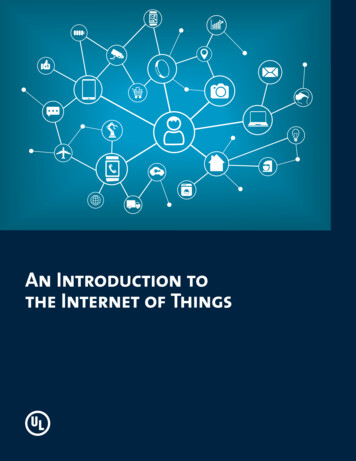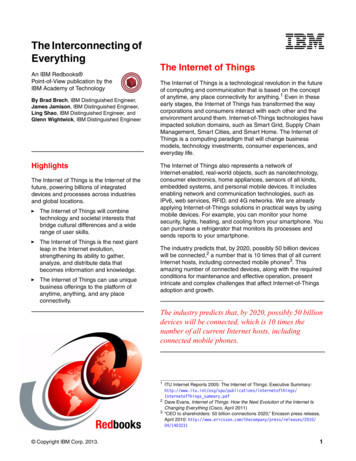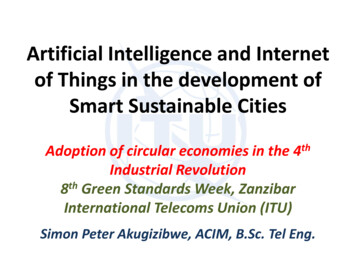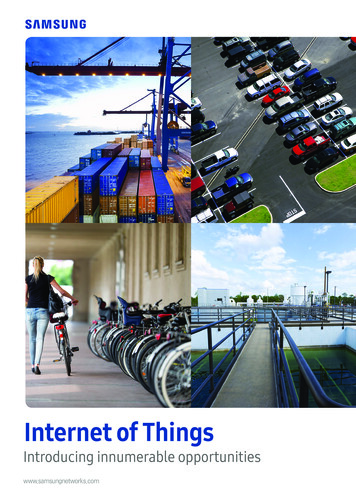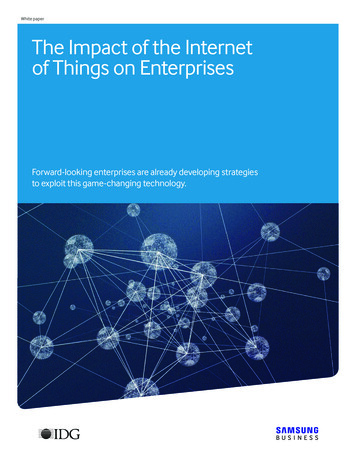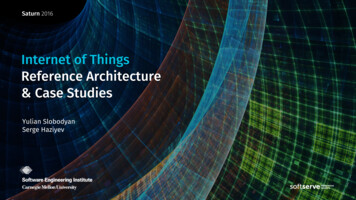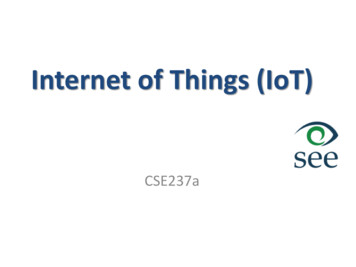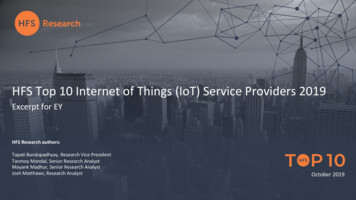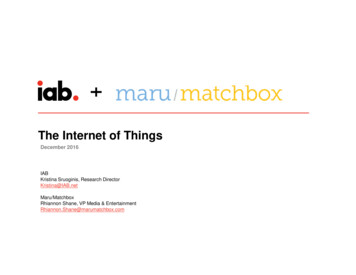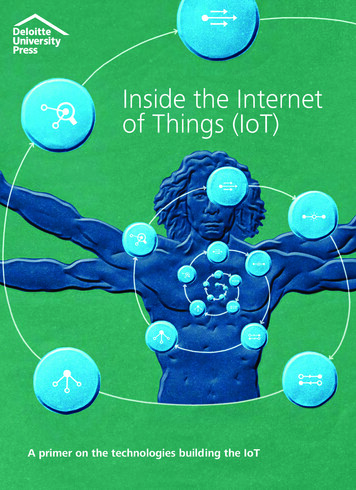
Transcription
Inside the Internetof Things (IoT)A primer on the technologies building the IoT
Inside the Internet of Things (IoT)About the authorsJonathan HoldowskyJonathan Holdowsky is a senior manager with Deloitte Services LP and part of Deloitte’s EminenceCenter of Excellence. In this role, he has managed a wide array of thought leadership initiatives onissues of strategic importance to clients within consumer and manufacturing sectors.Monika MahtoMonika Mahto is a senior analyst with Deloitte Services India Pvt. Ltd and part of Deloitte’sEminence Center of Excellence. Over the last seven years, she has been involved in various strategicresearch assignments for clients in the consumer and industrial products industry.Michael E. RaynorMichael E. Raynor is a director with Deloitte Services LP and the director of the Center forIntegrated Research (CIR). In collaboration with a broad cross-section of Deloitte professionalsfrom many different industries, the CIR designs, executes, and supports research into some of themost important issues facing companies today.Mark CotteleerMark Cotteleer is a research director with Deloitte Services LP, affiliated with Deloitte’s Center forIntegrated Research. His research focuses on operational and financial performance improvement,in particular, through the application of advanced technology.AcknowledgementsThe authors would like to thank Sadashiva S.R. (Deloitte Services India Pvt. Ltd.), Dhaval Modi(Deloitte Consulting India Pvt. Ltd.), and Joe Mariani (Deloitte Services LP) for their research contributions; Gaurav Kamboj and Kritarth Suri (both with Deloitte Consulting LLP) for their contributions to the IoT technology architectures; and Athappan Balasubramanian (Deloitte SupportServices India Pvt. Ltd.) for his graphics contributions to this report.Deloitte’s Internet of Things practice enables organizations to identify where the IoT can potentially create value in their industry and develop strategies to capture that value, utilizing IoT foroperational benefit. To learn more about Deloitte’s IoT practice, visit things.html.Read more of our research and thought leadership on the IoT at http://dupress.com/collection/internet-of-things.
A primer on the technologies building the IoTContentsThe Information Value LoopSensors 2 5Networks 10Standards 16Augmented intelligence 21Augmented behavior 26The IoT technology architectureClosing thoughtsGlossary 33 38 39Endnotes 441
Inside the Internet of Things (IoT)The Information Value LoopIF you’ve ever seen the “check engine” lightcome on in your car and had the requisiterepairs done in a timely way, you’ve benefitedfrom an early-stage manifestation of whattoday is known as the Internet of Things (IoT).Something about your car’s operation—anaction—triggered a sensor,1 which communicated the data to a monitoring device. The significance of these data was determined basedon aggregated information and prior analysis.Figure 1. The Information Value rkCOMMUNICATEAGGREGATEStandardsVA LU E D R I V E R SS TAG E ST E C H N O LO G I E SC R E AT E : The use of sensors to generate information about a physical event or state.C O M M U N I C AT E : The transmission of information from one place to another.AG G R E G AT E : The gathering together of information created at different times or from different sources.A N A LY Z E : The discernment of patterns or relationships among phenomena that leads to descriptions, predictions, or prescriptions for action.AC T: Initiating, maintaining, or changing a physical event or state.Source: Deloitte analysis.2Graphic: Deloitte University Press DUPress.com
A primer on the technologies building the IoTThe light came on, which in turn triggered atrip to the garage and necessary repairs.In 1991 Mark Weiser, then of XeroxPARC, saw beyond these simple applications. Extrapolating trends in technology, hedescribed “ubiquitous computing,” a world inwhich objects of all kinds could sense, communicate, analyze, and act or react to people andother machines autonomously, in a mannerno more intrusive or noteworthy than how wecurrently turn on a light or open a tap.One way of capturing the process implicitin Weiser’s model is as an Information ValueLoop with discrete but connected stages. Anaction in the world allows us to create information about that action, which is then communicated and aggregated across time and space,allowing us to analyze those data in the serviceof modifying future acts.Although this process is generic, it isperhaps increasingly relevant, for the futureWeiser imagined is more and more uponus—not thanks to any one technologicaladvance or even breakthrough but, rather, dueto a confluence of improvements to a suite oftechnologies that collectively have reachedlevels of performance that enable completesystems relevant to a human-sized world.As illustrated in figure 2 below, each stageof the value loop is connected to the subsequent stage by a specific set of technologies,defined below.The business implications of the IoT areexplored in an ongoing series of Deloittereports. These articles examine the IoT’simpact on strategy, customer value, analytics, security, and a wide variety of specificapplications. Yet just as a good chef shouldhave some understanding of how the stoveworks, managers hoping to embed IoTenabled capabilities in their strategies are wellserved to gain a general understanding of thetechnologies themselves.Figure 2. The technologies enabling the Internet of ThingsTechnologyDefinitionExamplesSensorsA device that generatesan electronic signal froma physical condition oreventThe cost of an accelerometer has fallen to 40 cents from 2 in 2006.2Similar trends have made other types of sensors small, inexpensive,and robust enough to create information from everything from fetalheartbeats via conductive fabric in the mother’s clothing to jet enginesroaring at 35,000 feet.3NetworksA mechanism forcommunicating anelectronic signalWireless networking technologies can deliver bandwidths of 300megabits per second (Mbps) to 1 gigabit per second (Gbps) with nearubiquitous coverage.4StandardsCommonly acceptedprohibitions orprescriptions for actionTechnical standards enable processing of data and allow forinteroperability of aggregated data sets. In the near future, we couldsee mandates from industry consortia and/or standards bodies relatedto technical and regulatory IoT standards.AugmentedintelligenceAnalytical tools thatimprove the ability todescribe, predict, andexploit relationshipsamong phenomenaPetabyte-sized (1015 bytes, or 1,000 terabytes) databases can now besearched and analyzed, even when populated with unstructured (forexample, text or video) data sets.5 Software that learns might substitutefor human analysis and judgment in a few situations.AugmentedbehaviorTechnologies andtechniques that improvecompliance withprescribed actionMachine-to-machine interfaces are removing reliably fallible humanintervention into otherwise optimized processes. Insights intohuman cognitive biases are making prescriptions for action based onaugmented intelligence more effective and reliable.6Source: Deloitte analysis.3
Inside the Internet of Things (IoT)To that end, this document serves as atechnical primer on some of the technologiesthat currently drive the IoT. Its structure follows that of the technologies that connect thestages of the Information Value Loop: sensors,networks, standards, augmented intelligence,and augmented behavior. Each section in thereport provides an overview of the respective technology—including factors that driveadoption as well as challenges that the technology must overcome to achieve widespreadadoption. We also present an end-to-end IoT4technology architecture that guides the development and deployment of Internet of Thingssystems. Our intent, in this primer, is not todescribe every conceivable aspect of the IoT orits enabling technologies but, rather, to providemanagers an easy reference as they exploreIoT solutions and plan potential implementations. Our hope is that this report will helpdemystify the underlying technologies thatcomprise the IoT value chain and explain howthese technologies collectively relate to a largerstrategic framework.
A primer on the technologies building the sNetworkCOMMUNICATEAGGREGATEStandardsAn overviewFigure 3. A temperature sensorMOST “things,” from automobiles toZambonis, the human body included,have long operated “dark,” with their location,position, and functional state unknown oreven unknowable. The strategic significance ofthe IoT is born of the ever-advancing abilityto break that constraint, and to create information, without human observation, in allmanner of circumstances that were previouslyinvisible. What allows us to create information from action is the use of sensors, a genericterm intended to capture the concept of asensing system comprising sensors, microcontrollers, modem chips, power sources, andother related devices.A sensor converts a non-electrical inputinto an electrical signal that can be sent to anelectronic circuit. The Institute of Electricaland Electronics Engineers (IEEE) provides aformal definition:An electronic device that produceselectrical, optical, or digital data derivedfrom a physical condition or event. Dataproduced from sensors is then electronically transformed, by another device,into information (output) that is usefulin decision making done by “intelligent”devices or individuals (people).7The technological complement to a sensor is an actuator, a device that converts anelectrical signal into action, often by converting the signal to nonelectrical energy, such asmotion. A simple example of an actuator is anelectric motor that converts electrical energyinto mechanical energy. Sensors and actuatorsbelong to the broader category of transducers:A sensor converts energy of different formsinto electrical energy; a transducer is a devicethat converts one form of energy (electricalNonelectrical stimulusLCD displayTemperaturesensorElectrical signalElectroniccircuitGraphic: Deloitte University Press DUPress.comor not) into another (electrical or not). Forexample, a loudspeaker is a transducer becauseit converts an electrical signal into a magneticfield and, subsequently, into acoustic waves.Different sensors capture different types ofinformation. Accelerometers measure linearacceleration, detecting whether an object ismoving and in which direction,8 while gyroscopes measure complex motion in multipledimensions by tracking an object’s positionand rotation. By combining multiple sensors,each serving different purposes, it is possibleto build complex value loops that exploit manydifferent types of information. For example: Canary: A home security system thatcomes with a combination of temperature, motion, light, and humidity sensors.Computer vision algorithms analyze patterns in behaviors of people and pets, whilemachine learning algorithms improve theaccuracy of security alerts over time.9 Thingsee: A do-it-yourself IoT device thatindividuals can use to combine sensorssuch as accelerometers, gyroscopes, andmagnetometers with other sensors that5
Inside the Internet of Things (IoT)measure temperature, humidity, pressure,and light in order to collect personallyinteresting data.10Types of sensorsSensors are often categorized based ontheir power sources: active versus passive.Active sensors emit energy of their own andthen sense the response of the environmentto that energy. Radio Detection and Ranging(RADAR) is an example of active sensing: ARADAR unit emits an electromagnetic signal that bounces off a physical object and is“sensed” by the RADAR system. Passive sensors simply receive energy (in whatever form)that is produced external to the sensing device.A standard camera is embedded with a passivesensor—it receives signals in the form of lightand captures them on a storage device.Passive sensors require less energy, butactive sensors can be used in a wider rangeof environmental conditions. For example,RADAR provides day and night imagingcapacity undeterred by clouds and vegetation,while cameras require light provided by anexternal source.11Figure 4 provides an illustrative list of 13types of sensors based on the functions theyperform; they could be active or passive perthe description above.Of course, the choice of a specific sensor isprimarily a function of the signal to be measured (for example, position versus motionsensors). There are, however, several genericfactors that determine the suitability of a sensor for a specific application. These include, butare not limited to, the following:12 Accuracy: A measure of how precisely asensor reports the signal. For example,when the water content is 52 percent, a sensor that reports 52.1 percent is more accurate than one that reports it as 51.5 percent. Repeatability: A sensor’s performance inconsistently reporting the same response6when subjected to the same input underconstant environmental conditions. Range: The band of input signals withinwhich a sensor can perform accurately.Input signals beyond the range lead to inaccurate output signals and potential damageto sensors. Noise: The fluctuations in the outputsignal resulting from the sensor or theexternal environment. Resolution: The smallest incrementalchange in the input signal that the sensorrequires to sense and report a change in theoutput signal. Selectivity: The sensor’s ability to selectivelysense and report a signal. An example ofselectivity is an oxygen sensor’s ability tosense only the O2 component d
IoT solutions and plan potential implementa-tions. Our hope is that this report will help demystify the underlying technologies that comprise the IoT value chain and explain how these technologies collectively relate to a larger strategic framework. Inside the Internet of Things IoT: 4
